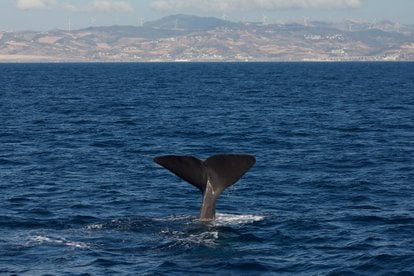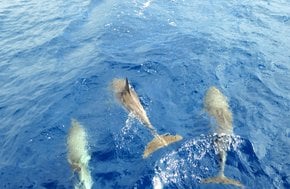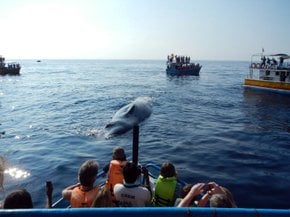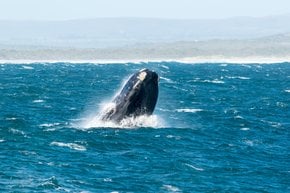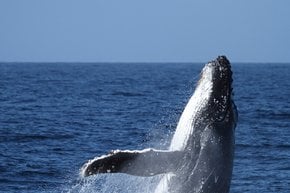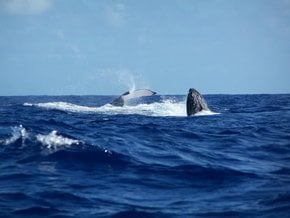Whale Watching in Spain 2026
Don't miss your chance to get close to these marine mammals in their natural habitat in the Strait of Gibraltar
Best time: March–October
Whale watching in Spain offers a unique opportunity to observe marine giants in their natural environment, with the country’s diverse geography providing multiple spots for this activity. From the warm waters of the Canary Islands to the nutrient-rich Strait of Gibraltar, Spain is home to numerous whale species, making it a prime destination for marine enthusiasts.
Whale Watching Season
Whale watching in Spain is generally a seasonal activity, with tours typically running between March and October. According to local operators, this period offers the highest chance of sightings. However, the exact timing may vary depending on the region and species. For example, orca sightings in the Strait of Gibraltar are most common from June to August, while sperm whales are often seen between April and August. In the Canary Islands, however, whale watching is possible year-round due to the resident populations of pilot whales and dolphins.
Best Places for Whale Watching
The Strait of Gibraltar
Located at the southernmost point of mainland Europe, the Strait of Gibraltar is one of the top whale-watching spots in Spain. Boats typically depart from the town of Tarifa, a small coastal town about two hours from Seville. The strait is a migration route for numerous species, including orcas, sperm whales, and dolphins. The convergence of the Atlantic Ocean and the Mediterranean Sea creates a nutrient-rich environment, attracting marine mammals throughout the year.
Canary Islands
The Canary Islands, particularly Tenerife and La Gomera, are some of the best places in Spain for whale watching. More than 30 species of cetaceans have been spotted in these waters, including pilot whales, sperm whales, and even the elusive blue whale. Tenerife is known for its resident population of pilot whales and bottlenose dolphins, which can be seen all year long. The deep waters between the islands provide ideal conditions for marine life.
Bay of Biscay
The northern coast of Spain, specifically the Bay of Biscay, offers another excellent whale-watching location. Tours departing from cities like Bilbao and Santander give visitors the chance to spot species such as minke whales, fin whales, and sei whales. The deeper waters further offshore also attract several species of beaked whales, which are more difficult to spot but add to the region’s appeal.
Tours and Price Range
Whale-watching tours in Spain typically last two to three hours, depending on the location and the likelihood of sightings. In areas like the Strait of Gibraltar, operators sometimes extend tours when orca sightings are probable. Prices generally range from €30 to €60 per person, with private or luxury tours being more expensive. It’s recommended to book tours in advance, especially during peak season, and to confirm the day before, as weather conditions may cause cancellations.
Location and Infrastructure
Many of Spain’s whale-watching destinations are conveniently located near major cities or tourist attractions. Tarifa, in the Strait of Gibraltar, is a short drive from Seville, and the town itself is a hub for water sports, including kite surfing. In the Canary Islands, whale-watching tours often depart from popular tourist towns such as Puerto Colón in Tenerife. The Bay of Biscay is accessible from cities like Bilbao, known for its cultural landmarks such as the Guggenheim Museum. These locations offer a mix of natural beauty and cultural activities, making them ideal for extended stays.
The Most Commonly Spotted Species
Spain’s waters are home to a wide variety of marine species. In the Strait of Gibraltar, orcas, sperm whales, and various species of dolphins are commonly spotted. Pilot whales are residents in both the Strait of Gibraltar and the Canary Islands, where bottlenose dolphins are also prevalent. In the Bay of Biscay, larger species like minke and fin whales are often sighted, along with rare beaked whales. Seasonal sightings include orcas during the tuna migration in summer and sperm whales during the spring and summer months.
Tips for Whale Watching
Be aware that windy and foggy conditions, especially in Tarifa, may result in tour cancellations. Always confirm your booking the day before your trip. Comfortable clothing, sunscreen, and motion sickness medication are recommended, as sea conditions can vary. Binoculars and cameras with zoom lenses will enhance the experience.
Whale watching in Spain offers an unforgettable experience, allowing visitors to witness the grace and power of marine life in stunning natural settings. Whether you’re in the warm Canary Islands or the historic town of Tarifa, the opportunity to see whales up close shouldn’t be missed.
Visitor Reviews
Rove.me reached out to Alex (from Austria) and Ola (from Poland), who have visited Tarifa for whale watching several times with their families and friends. We asked them about their experiences and any potential drawbacks of whale watching in this location.
According to Alex and Ola, whale watching in Tarifa is always a great adventure and an excellent way to enhance their stay in the area. They recommend visiting during the summer months when the weather is warm and the sea is calmer. Ola noted that windy or bad weather can make the experience less enjoyable, suggesting that visitors should bring a windproof jacket just in case. Alex added, "It's important to choose a day without wind to fully enjoy the trip or simply prepare yourself with appropriate clothing."
Both of them appreciated the informative pre-tour talk conducted by the crew, which is offered in multiple languages, including English, Spanish, and German. This introduction helps passengers understand what to expect during the tour and learn to recognize different marine species. "For some of the pilot whales, they even have names and can recognize them during the trip, which makes it quite special," shared Ola.
They described the boat as large and stable, which helps in minimizing seasickness. The atmosphere on board is relaxed, and the crew makes safety a priority. Alex also pointed out that the tour is run by a foundation dedicated to preserving marine life in the Strait of Gibraltar, adding, "It feels more like a scientific experience rather than just a fun outing." Both agreed that the dedication of the biologists and volunteers adds an extra dimension to the experience.
In terms of marine life, dolphins and pilot whales are consistently seen, and the presence of a guide on board enhances the experience. Ola mentioned, "It's always exciting to witness the lives of these amazing creatures up close." The crew ensures a respectful distance from the animals, but they noted that the dolphins and whales often seem curious and approach the boat on their own.
One unique aspect they highlighted is that if no animals are spotted, the tour can be repeated another day at no additional cost. "The only time this might happen is when the sea is too rough, making it difficult to find them," Alex explained.
Overall, Alex and Ola enthusiastically recommend whale watching in Tarifa, with Alex concluding, "I would 100% recommend it to everybody, and I'll definitely go again because I enjoy it every time."





